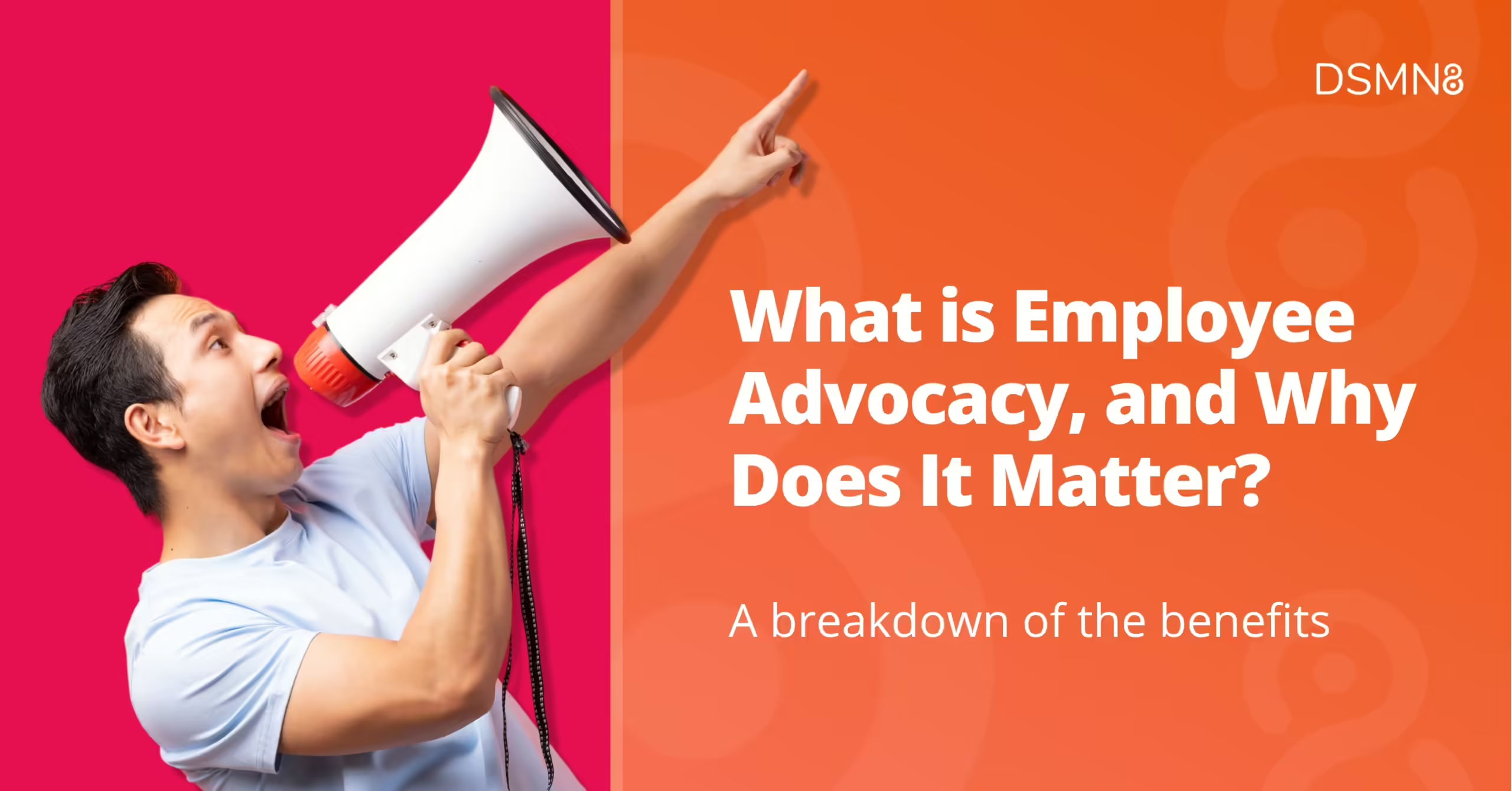
If you’re here… it’s because you’re at the start of your employee advocacy journey.
And frankly, that’s awesome. Prepare to have your mind blown, and to rethink the way you promote your company on social media!
Today we’re covering everything you need to know about employee advocacy: what it is, examples, results you can expect to see, what an employee advocacy platform does, and best practices.
You’ll also find free resources to support starting and scaling your own program throughout!
The Definition of Employee Advocacy
Employee advocacy is the promotion of an organization or its products/services by its employees.
An employee advocate creates positive exposure for your company by sharing content or “advocating” for your products or services.
These employee brand ambassadors amplify your company’s online presence by sharing brand messages with their own professional and personal social networks. This typically occurs on platforms known for professional networking such as LinkedIn or X/Twitter.
In a nutshell, employee advocacy is word-of-mouth marketing by employees on social media.
When you think of brand advocates, you might think of bringing in external people or influencers. However, unlike traditional influencer marketing… employees aren’t being paid extra to do it.
Employee advocacy is simply an employee sharing company content with their social media network.
What Exactly is Employee Advocacy?
We’ve covered the definition of employee advocacy. But in practice, it takes a number of forms. Let’s look at some examples to fully understand what employee advocacy is:
If one of your colleagues shares a blog post or news article by your company on LinkedIn, that is employee advocacy.
Or maybe they’re writing an original post, sharing their insights on a recent industry development. In this case, they’re building their personal brand, establishing themselves as a thought leader. In turn, this activity increases credibility and trust in your company. So that’s also a form of employee advocacy.
Perhaps your organization has recently taken part in some volunteering or hosted a charity fundraising event. When your colleagues share photos from the event on LinkedIn, it supports the positive reputation of your organization and its’ corporate social responsibility (CSR) initiatives.
You guessed it, that’s another form of employee advocacy.
If you share a behind-the-scenes photo from a company away day on Instagram… that is also employee advocacy. You’d be promoting your company culture, elevating your organization’s employer brand to showcase the organization as a great place to work. Depending on the nature of the photo anyway!
What is an Example of Employee Advocacy?
Now you know what employee advocacy is and the various forms it takes, let’s look at some specific examples.
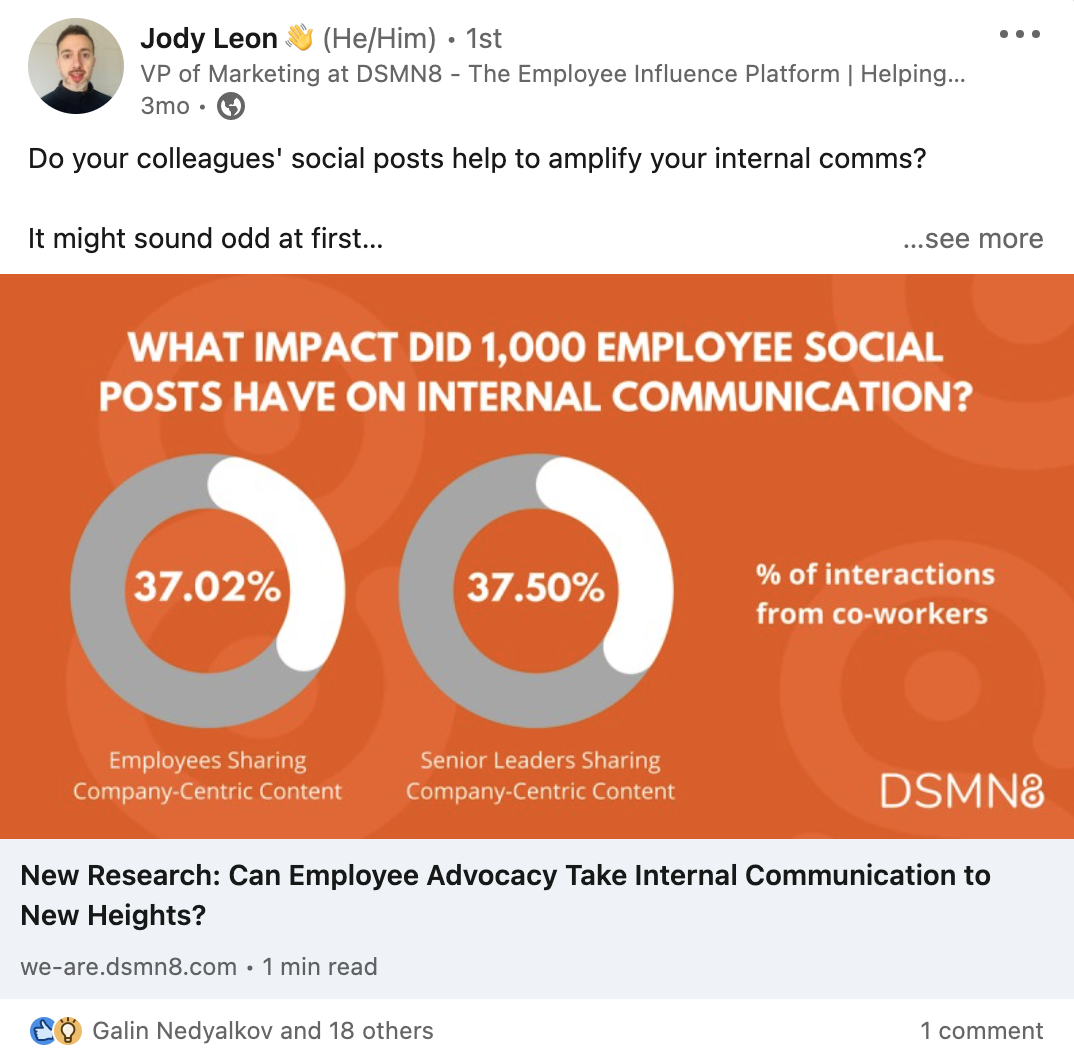
Here’s our VP of Marketing, Jody Leon, doing the most! 💪
He shares a graphic featuring data from a report we put together about the impact employee advocacy has on internal communications. This is an educational and informative post, providing value to his network of marketers.

Here’s a completely different style of employee advocacy content, by Gymshark’s Chief Brand Officer, Noel Mack.
Noel’s post is a great example of authentic employee-generated content. His photo, shared on Instagram, shows off a Gymshark sign while he wears sports clothing.

Finally, here’s an example from DSMN8 client, Dropbox. Here, Masha reshares a post by her colleague about their paid volunteering days, adding her own commentary.
This is a great example of showcasing corporate social responsibility and company culture, all with authentic employee-generated content 👏
For more employee advocacy examples, check these out:
Why Has Employee Advocacy Become Popular?
Employee advocacy has been a trending topic in marketing for years.
With the rise of influencers over the past decade (and more recently, B2B influencers), forward-thinking brands understood the power of having internal or in-house influencers. They started encouraging their teams to build a social media presence.
So why is everyone talking about employee advocacy now? 🤔
Well, when 2020 hit, brands had to adapt. Networking and marketing shifted to a 100% digital strategy.
And companies quickly realized the role their employees could play, leveraging their networks for marketing, sales, and recruitment.
Combine this with increasing costs for paid social media advertising and influencers, and you can see why many marketing teams with reduced budgets are leaning on employees for content distribution instead.
So much so that Gartner predicted that by the end of 2023, 90% of B2B marketing strategies would have scaled employee advocacy programs.
Largely fueled by the shift to remote working in 2020, employee advocacy has gone from a “nice-to-have” to a “must-have” for organizations across the globe.
Does Employee Advocacy Work?
To put it bluntly… yes.
Here’s why:
People want to hear from people, not brands.
This is especially true on social media: we’re much more likely to follow a company’s employees or their CEO than the company itself.
Buyers want transparency and authenticity now more than ever. A message from a “regular” employee simply has a much more trustworthy feel to it than a post from the company channel.
And that’s not all. Trust in brands is declining year on year.
The Edelman Trust Barometer found that almost two-thirds of people are inclined to distrust organizations.
In fact, 76% of people say they’d trust a message from someone they know over any form of branded content.
But that’s only half of the story: it’s also about the ability to reach the right audience.
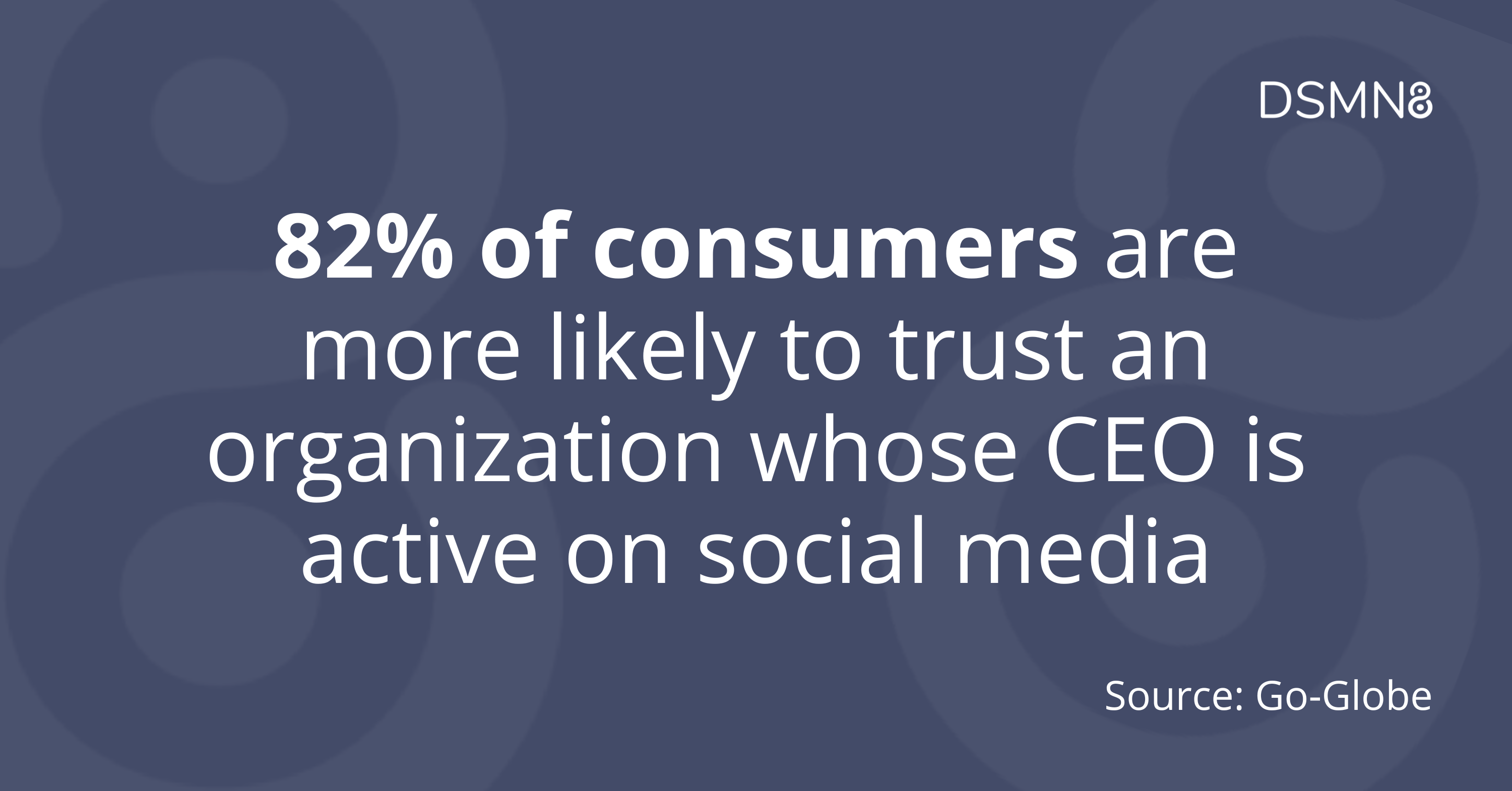
Edelman & LinkedIn’s 2024 B2B Thought Leadership report revealed that:
“75% of decision-makers and C-Suite executives say that a piece of thought leadership has led them to research a product or service they were not previously considering.”
So not only does employee advocacy support increased brand reach, it also helps generate demand.
But what does all of this translate to in terms of marketing, HR, and sales benefits?
On average, employee posts receive 8x more engagement than company posts. Plus, brand messages were found to reach up to 561% more people when shared by employees.
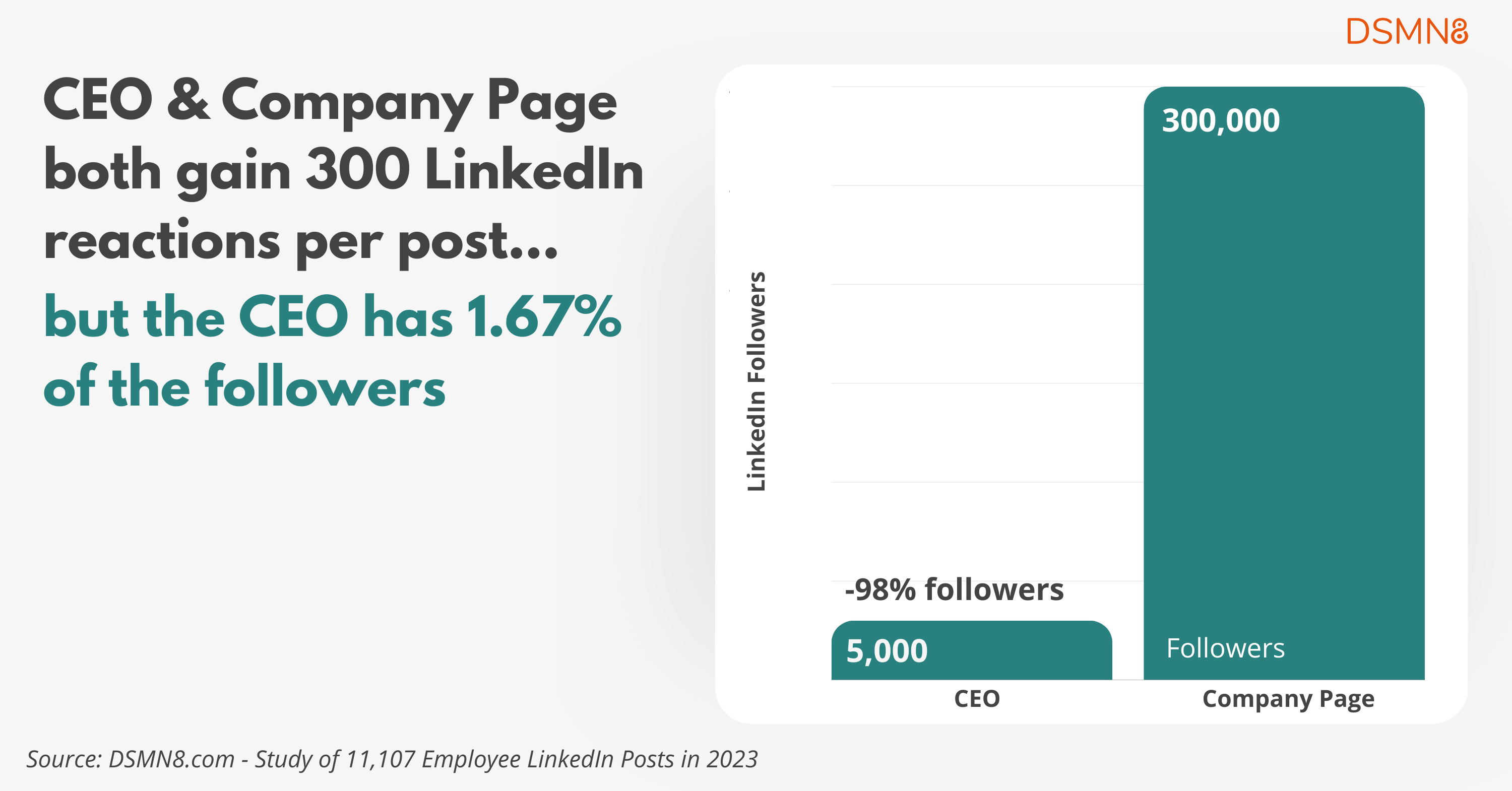
We analyzed 11,107 employee LinkedIn posts from 2023, and the results were clear: executive influence is huge.
In fact, the CEO of a civil engineering organization generated the same level of LinkedIn engagement with under 5,000 followers as the company page with over 300,000 followers.
That’s the same results, with 98% fewer followers.
Related post: more employee advocacy statistics you need to know.
A good employee advocacy program will:
🔸 Amplify company messages via employees’ networks.
🔸 Offer an “inside look” at life at your company to attract top talent.
🔸 Allow your employees to build personal brands, positioning themselves as subject matter experts and thought leaders.
What is an Employee Advocacy Platform?
So what does an employee advocacy platform do? 🤔
In its simplest form, an employee advocacy platform helps you manage your employee advocacy program. It provides a space for all of your company content, for employees to easily find and share it with their networks.
Some platforms purely provide the essentials for managing your advocacy program, while others include features like gamification, the ability to segment users based on departments or regions, internal comms functions, and comprehensive analytics.
The goal of an employee advocacy platform is to make it as easy as possible for employees to participate. Things like having a mobile app for employees who aren’t desk-based and automation for time-poor executives makes a huge difference.
We’ve written a guide on how to choose the right employee advocacy platform based on your organization’s requirements, so give that a read if you’re looking to learn more.
Do You Need an Employee Advocacy Platform?
Well, strictly speaking, no. Not to begin with anyway.
But, speaking from experience… scaling an employee advocacy program is really tough without a platform 😩
We’ve written a detailed guide on the various ways to manage an employee advocacy program, from taking a ‘manual’ approach to using a combination of social media management and employee communications tools.
But for now, let’s cover the basics:
If you’re starting a small program of around 20 employees, it can be managed manually, i.e. using your existing internal comms solution or email to provide your team with fresh content to share.
But once your program grows, particularly across departments and regions, providing advocates with tailored content suited for their audiences becomes essential.
The last thing you want is 50 employees sharing identical content on social media!
An employee advocacy platform makes it easy for your team to find and share content, while including engagement features such as gamification and automation.
Plus, without technology in place, you lose the ability to monitor the performance of your employees’ social media efforts and demonstrate ROI.
Sure, without a platform you can track things like employee followers and content impressions in a spreadsheet, for example.
But what about the really good stuff?! 😱
You want to be able to track things like website clicks and comparative cost-per-click, and find out which content is generating the most engagement to level up your content marketing strategy.
Not to mention the fact that monitoring metrics manually becomes extremely difficult with any more than around 5-10 employees, as it requires them to manually enter their data on a consistent basis.
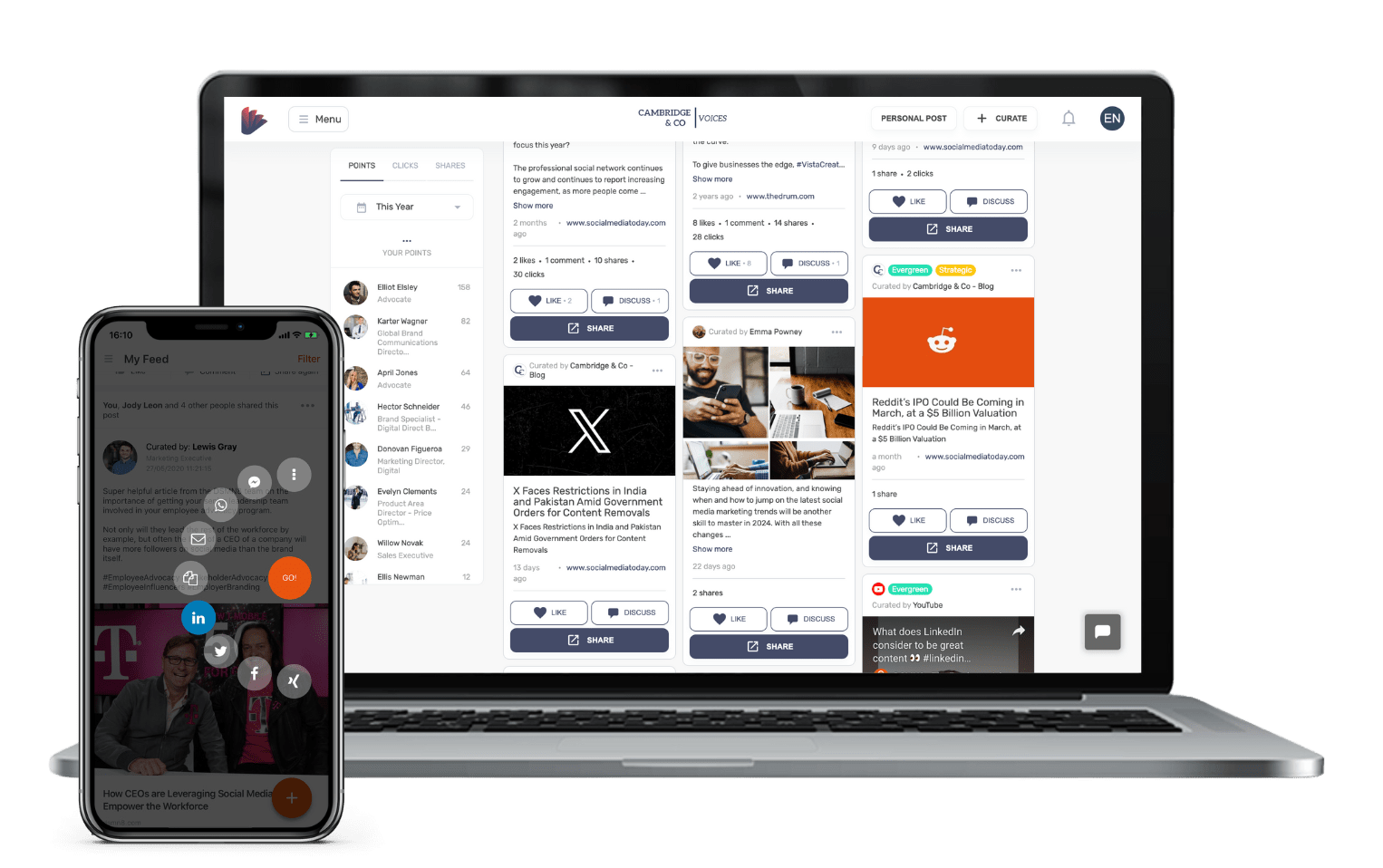
With DSMN8, you can centralize all of your company content, making it easy for every employee to find and share relevant content with their networks.
You can even offer multiple pre-approved captions for employees to use when sharing to social media.
This ensures your advocates stay on-brand and compliant, reduces the time they need to invest in social media, and creates endless variations on the same piece. No more identical posts!
You can also incentivize people to share with gamification features, including claimable rewards and leaderboards to highlight top performers and incite friendly competition.
Most importantly though, our analytics suite allows you to measure the advocacy program’s performance as a whole, at team level, and individual users.
You can measure everything from clicks generated to comparative cost-per-click and earned media value (ROI) in real-time.
Related post: Employee Advocacy Metrics to Track for Measuring Success.
Check out the 90 second product tour video below for a peek into the DSMN8 platform and how it works! 👇
Learn More about Employee Advocacy:
For expert insights and bite-sized tips, grab a copy of Employee Advocacy: 101 Cheat Codes by Bradley Keenan 📙
To become an employee advocacy pro yourself, I recommend signing up for the Employee Advocacy Certification Course 🎓
It’s free, and will teach you everything you need to know about starting your own program, no platform required. Plus, you’ll achieve a shiny new certificate to add to your LinkedIn profile!
Lewis Gray
Senior Marketing Manager and Employee Advocacy Program Manager at DSMN8. Lewis specialises in content strategy, growing brand visibility and generating inbound leads. His background in Sales lends itself well to demand generation in the B2B niche.




